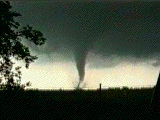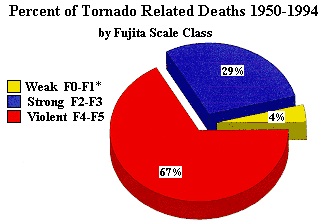

Hazard Vulnerability Assessment
Tornados
General information index. Also see Current Hazard Mitigation. See the Alexander County tornado history map.
Alexander County, like much of North Carolina, has had experience with tornados in recent history. The most recent out break of tornado activity was May 5, 1999. All tornados recorded or suspected in Alexander County have been of the F0 and F1 class. Research into tornados in Alexander County has shown that each "section" of the county (north, south, east and west) has experienced this violent type of storm. History has also shown the type of tornado experienced displays a narrow path or track with a duration of less than one (1) minute. Damage estimates have averaged less than $350,000 per storm. There have been no deaths or serious injuries in the ten year period.
To a limited degree, the potential for tornado development is predictable, as is the possible track of storms likely to produce tornados. Generally these storms develop south west of Alexander County and travel north east. Tornado watches and warnings are issued by the National Weather Service in Greenville/Spartanburg, SC.
While F5 tornados are very, very
rare, they are possible. It is also possible that a tornado can develop and
strike any facility, business or residential area. The entire county, including
the municipalities are vulnerable, as is the entire population. Reasonable
expectation, however would be for tornados of considerably less intensity,
resulting in a considerable reduction in the calculations below.
A key point to remember is the size of a tornado is not
necessarily an indication of its intensity.


This vulnerability assessment assumes worst case (F5)
that travels the entire length or width of the county:
Table T1
** Potential Economic Impact from an F5 tornado, catastrophic wind event or earthquake
| Structural Damage | $56,330,000 |
| Non - structural (i.e. power distribution systems, etc.) | $179,470,000 |
| Contents | $74,670,000 |
| Lost inventory | $3,930,000 |
| Relocation losses (cost of relocating population) | $57,640,000 |
| Capital losses | $26,200,000 |
| Wages lost | $31,440,000 |
| Retail income losses | $22,270,000 |
| Total Potential Losses | $451,192,000 |
The potential for debris generation is provide below as information for planners, solid waste professionals and county executives as a planning tool for the need for possible landfill space. Debris management following a major wind event is a costly and time consuming portion of disaster recovery. Costs are associated with debris and efforts to reduce the amount of debris that would be stored in a landfill may become a mitigation measure for the future.
Table T2
*** Potential Debris generated from an F5 tornado or catastrophic wind event
| TOTAL CUBIC YARDS | 435,831 |
| Total Acres needed to bury | 45 |
| Storage acres needed | 27 |
| Processing acres needed | 18 |
| Woody Debris (cubic yards) | 130,749 |
| Construction and demolition debris (cubic yards) | 305,082 |
| Burnable debris (cubic yards) | 128,134 |
| Soil debris (cubic yards) | 15,254 |
| Metals (cubic yards) - possible recycle | 45,762 |
| Landfilled debris (cubic yards) | 115,931 |
| Minimum cubic yards potential (+/- 30%) | 305,082 |
| Maximum cubic yards potential (+/- 30%) | 566,580 |
Table T3
**** Potential Death and injury totals from an F5 tornado or catastrophic wind event
| Deaths | 50 |
| Serious Injury | 100 |

The "Percentage of Tornado-Related Deaths 1950-1994" pie chart
shows that while violent tornados are few in number, they cause a very high percentage of tornado-related deaths. The Tornado Project has analyzed data prior to 1950, and found that the percentage of deaths from violent tornados was even greater in the past. This is because the death tolls prior to the introduction of the forecasting/awareness programs were enormous: 695 dead (Missouri-Illinois-Indiana, March 18, 1925); 317 dead (Natchez, Mississippi, May 7, 1840);.255 dead (St. Louis, Missouri and East St. Louis, Illinois, May 27, 1896); 216 dead (Tupelo, Mississippi, April 5, 1936); 203 dead (Gainesville, GA, April 6, 1936). In more recent times, no single tornado has killed more than 50 people since 1971.
*Source - NC Department of Commerce Economic Development
Information System
** HAZUS Information Data base - FEMA - Dunn and Bradstreet 1994. Adjusted to
2002 by 31%. Worst case scenario.
*** Debris management program mathematical formulas - FEMA- NCDEM- GCEM- 1999
**** Based on historical information 1950 - 2000 - Tornado Project Online (www.tornadoproject.com)